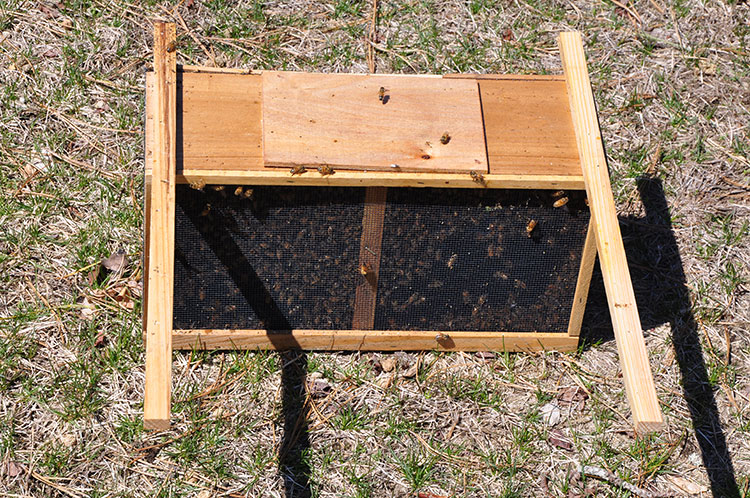• by Dr. Sarah D. Oktay •
Managing Director UMass Boston Nantucket Field Station
Bees are in the news and on the minds of people all over America as we evaluate how we fertilize and protect our crops and gardens and ensure food ends up on our tables. Both the imported bees we depend on for our honey and crop pollination and the native bees that pollinate our diverse flora are in trouble from a variety of attacks. Almost everyone has heard of colony collapse disorder, which is the sudden and widespread disappearance of adult honeybees from hives in the U.S. Last year the United States Department of Agriculture (USDA) released a report that shows that a variety of issues are likely involved in CCD and their executive summary listed the following culprits which work in tandem to impact bees (www.usda.gov/documents/ReportHoneyBeeHealth.pdf).
- The parasitic mite Varroa destructor remains the single most detrimental pest of honey bees, and is closely associated with overwintering colony declines.
- Multiple virus species have been associated with CCD. A new virus called Tobacco ringspot virus has just shown this year to be found in many bees by the USDA (link to article below).
- Varroa is known to cause amplified levels of viruses.
- The bacterial disease European foulbrood is being detected more often in the U.S. and may be linked to colony loss.
- Nutrition has a major impact on individual bee and colony longevity.
- Research indicates that gut microbes associated with honey bees play key roles in enhancement of nutrition, detoxification of chemicals, and protection against diseases.
- Acute and sublethal effects of pesticides on honey bees have been increasingly documented, and are a primary concern.
Two Nantucket High school students decided they wanted to know more about the risks bees may be encountering as they fly around Nantucket. As a rule of thumb the foraging area around a beehive extends for two miles (3 km), although bees have been observed foraging twice and three times this distance from the hive. Bees don’t know if the plant they are visiting is one that has been dusted with pesticides in a garden, or a wildflower that has been untouched by humans. Without pollinators, which include birds, bats butterflies, moths, and flies, many plants simply would not be able to reproduce. Bees are one of the most important and effective pollinating insects and their interdependence with plants makes them an excellent example of the type of symbiosis known as mutualism, an association between unlike organisms that is beneficial to both parties. They are found on every continent except Antarctica, in every habitat on the planet that contains insect-pollinated flowering plants.
When we think of bees, we usually think of the European honey bee which was brought over to pollinate our crops and produce honey and wax. We usually forget about the over 20,000 other species of bees (honey and otherwise) that pollinate everything from red cedar trees to blueberries to almonds supporting a $15 billion dollar industry in the U.S., $150 million of that is honey alone. North America and Canada are home to approximately 4500 species of bees. The domesticated European honeybee was introduced to North America 400 years ago by colonists at Jamestown and Williamsburg to provide their settlements with honey; few bees native to the continent produced enough honey to make harvesting viable. Since then, the honeybee has spread into every farmable corner of North America. Crops that depend on bees for pollination include: apples, oranges, lemons, and limes, broccoli, onions, blueberries, cherries, cranberries, cucumbers, cantaloupes, carrots, avocados, and almonds.
One of the best parts of my job is working with young people here on Nantucket doing a variety of research projects for science fairs, class projects, and for citizen science efforts here at the Field Station. During the past two years, I have been working with Nantucket High School students Mia Silverio and Sophie Davies on their research project on the concentration of carbaryl in Nantucket honey bees. They decided to investigate the amount of carbaryl (instead of neonicotinoids which are more well known bee toxin) in our island honey bees and honey and combs because it was the most frequently listed material in various herbicides and weed and feed products at Marine Home Center. From their abstract: “In this experiment, dead honey bees, honeycomb, and honey were tested for the pesticide carbaryl through the process of HPLC with UV detection (EPA method 8321B). Carbaryl is an insecticide sold at Marine Home Center on Nantucket that is mainly used to control moths, beetles, cockroaches, ants, ticks, and mosquitoes. Carbaryl is toxic to honey bees when in a concentration of 1540 nanograms, and toxic to humans when in a concentration of 0.0028 ug/ng. Concentrations of 1540 nanograms were not found, meaning that bees on Nantucket are not at risk for carbaryl poisoning. The highest concentration found was 13.51 nanograms in sample 13, a sample of honey from Kelley Road, followed by 12.31 nanograms in sample 18, a sample of honey from 52 Millbrook Road. Six of the samples contained carbaryl levels that were below detection.”
They ground up bees and honey and honeycomb collected from various beekeepers around the island, then these materials were dissolved into solvents in a process called extraction that could then be refined and passed through a machine called a High Performance Liquid Chromatograph with a Ultra Violet detector that can sense the amount of various pesticides and contaminants in samples based on the molecular weight of the material. This type of information is important for two reasons; you want to know where to place your hives and what is in your honey.
In a nutshell, they found very low levels of pesticides in the honey bees and honeycomb here on Nantucket, likely some of the lowest levels in the country! But in some samples, enough carbaryl was found to show that bees are harvesting plants that have been treated with pesticides or are close enough to treatment areas to pick up pesticide residues they found the highest levels in honey and less in the bees or honeycombs. Summer and spring honey had higher levels of pesticides than fall honey. These levels were nowhere near the amount that could harm bees, but there is a chance that even low levels could compromise the bee’s ability to fight off mites or viruses and other harmful agents. Last year’s research had slightly higher levels of carbaryl in the same general locations with another “hotspot” near Wauwinet. These pesticides are not only found in some chemicals used on farms that don’t use organic practices but also in many consumer products. Next time you go to the store, look at what you are buying to treat your roses or hydrangea—you may be surprised to see the alphabet soup of chemicals used for mite and aphid control.

Nantucket is home to several dozen beekeepers who have rekindled a beekeepers group to exchange ideas about hive maintenance, bee health and bee-havior (* sorry, I am allowed one pun per article). This group, called bACKyard Beekeepers, meets the first Sunday of each month during the off season at the Nantucket Field Station. Contact me at sarah.oktay@umb.edu and I’ll connect you with them.



